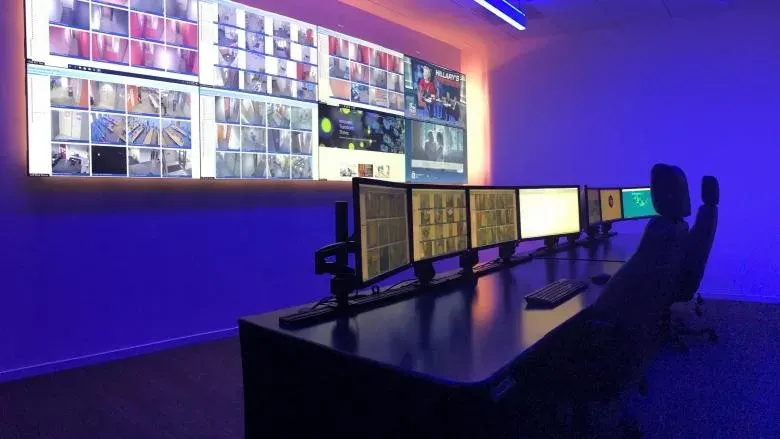Until recently, implementing a fully-functional control room that incorporates new and innovative technology was thought to only be a privilege for large organizations. Siloed, more localized command centers tend to fall into the trap of budgetary dread, and therefore, rarely utilize a data visualization solution.
Now, businesses and agencies with smaller footprints that come with a more limited budget can improve their ability to maintain an intelligent, 24/7 security posture with effective SOCs.
The two types of the security command center
Over the past few years, the unpredictability of diverse security threats — both cyber and physical — has become much more salient to organizations in a wide range of industries. Combined with the need to have more unified command and control over operations, today’s security command centers are built in all shapes and sizes.
That said, they generally fit into two buckets. The first includes global security operations centers (GSOCs) or fusion centers — generally the larger, more complex, and highly-integrated operations centers. These typically require a significant investment of resources and time — from a thorough discovery, needs analysis, and assessments of existing spaces and team workflows to integrations with an assortment of third-party software and power redundancy requirements.
The second type of SOC, the smaller security command centers, is often misguided in terms of what technologies and configurations are deemed appropriate for them. In some cases, the mission-critical nature of these spaces leads to a tendency to over-design. An attempt to mimic a GSOC can result in an excessive and counterproductive technology ecosystem, rooted in a bloated design and a bloated budget in a smaller SOC environment.
In other instances, these smaller, more siloed, and commonplace command centers are under-designed, and they end up looking as if a series of technology decisions were made with no strategic throughline. Picture multiple monitors haphazardly slapped on a wall extending from a PC or standard office furniture being mistakenly provided for operators working long shifts around the clock. With no focus, this translates into zero flexibility, no consideration for ease of use, and dismissing control room design best practices.
Four steps toward effective SOC design
While it’s true that control room expansion or refurbishment that involves the alignment of enhanced security technologies with more multifaceted operations can be best accomplished with a bespoke integration and a substantial investment; that’s not always the case. More often than not, small-to-medium command centers are not only better served but can capitalize on considering a few technology design and deployment best practices.
#1: Align operators with the overall security strategy of SOC
Avoid the pitfalls of wasted resources. By assessing past technology investments and current capabilities, it often becomes clear that simplicity and limiting excess can be the difference between productive and overwhelmed staff. A larger security strategy and operating procedures for a command center need to take into account an operator’s capability of realistically managing the workload. Too often, operators are burdened with technology that makes real-time monitoring, control, and incident management more of a hassle than they need to be.
Being mindful of the scope of work and aligning operator workflow with the overall strategy is key. It’s the starting point on the path toward actually leveraging the right mission-critical technologies in ways that are cost-effective and specific to operating environments.
#2: Research a video wall or displays of SOC
At the epicenter of control room environments is receiving information, analyzing it, and collaborating to perform a required action, communicate critical decisions, or respond to an emerging event or operational condition. Where and how this information should be visualized and effectively monitored is important, particularly for smaller environments that demand a more precise strategy behind operator visibility.
High-resolution video walls and large format displays are reliable and purpose-built technology solutions that enable operators to efficiently gather real-time information, assess potential risks, and engage in proactive response.
A single-pane-of-glass view of operations across infrastructure is possible when the right visualization solution is identified according to the scope of oversight functions, the number of operators, and the different types of data that need to be interpreted.
24/7-rated video walls or large format displays with wide viewing angles can provide sharp visibility of content. Cohesive viewing featuring data assimilation, maps, and a variety of detailed sources may help create an overall more simplified workflow experience.
#3: Improve modular data & content management of SOC
With data visualization in place, it can only prove useful if the content displayed is optimized. New forms of data integration and an increased need for collaborative decision-making are growing and evolving. From centralized dashboards to live streaming content and the dynamic display of video and other security inputs, it’s important to optimize the presentation of modular information and create configurations that align with what operators actually need to visualize.
There’s tremendous value in asking the question as it pertains to figuring out the right way to simplify a video wall and/or display design: what are the present and anticipated information sources that are required to comprise a day-to-day common operational picture?
In many cases, it hinges on a configured visualization system with an efficient video processor. These video controllers allow end users to determine and configure preferred display layouts with the added ability to integrate a number of video inputs that can be delivered to a multi-screen display or video wall.
And for command center environments where space and sound are at a premium, it’s important to choose a video processor that has a compact form factor and quiet performance but is still packed with power and reliability. Despite the smaller footprint, that doesn’t necessarily mean diminished capability.
#4: Consider an all-in-one command center solution SOC
Uniquely designed to address the needs of small and medium-security operations centers, finding an all-in-one solution can help security leaders avoid piecing together the right technology components and hoping they are compatible.
Some SOC solutions can be tailored to overcome the under-designed blunder as well. Leveraging best-practice deployments can result in a pre-engineered system that is purpose-built for those smaller command centers.
Smaller, but still mighty SOC
The demand for seamless video wall and/or display solutions that streamline operator workflows with security tools and technologies is on the rise. Yet, for small and medium SOCs, too often the assumption of a costly technology integration ends up becoming a major operational and budgetary roadblock.
Building a command center on a budget is made possible by following the aforementioned technology design and deployment best practices. Removing the complexities associated with larger, more demanding integrations opens up the possibilities of truly enhancing situational awareness with a single-pane-of-glass view of security operations.





